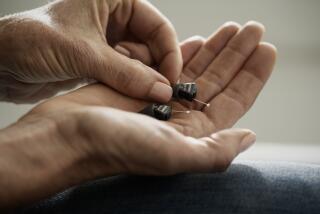Can you hear me now? More teens can’t
- Share via
Teenagers aren’t necessarily tuning out adults; they simply might not be able to hear them.
The proportion of teens in the United States with slight hearing loss has increased 30% in the last 15 years, and the number with mild or worse hearing loss has increased 77%, researchers said Tuesday.
One in every five teens now has at least a slight hearing loss, which can affect learning, speech perception, social skills development and self-image; one in every 20 has a more severe loss.
The authors of the report in the Journal of the American Medical Assn. eliminated ear infections and exposure to loud noises in the environment as causes for the hearing loss, but could not identify a specific cause. A recent Australian study, however, found a 70% increased risk of hearing loss associated with the use of headphones to listen to portable music, and many experts suspect they are the primary cause of hearing loss in teens.
“Personal stereos are the most important change in the culture in the last 15 to 20 years,” said Dr. Tommie Robinson Jr., president of the American Speech-Language-Hearing Assn. “Everybody has their own little device now, and how many times have you passed somebody and could hear their music?”
Even the relatively low level of damage found in the study can create problems.
“Just because a hearing loss is slight does not mean it is insignificant, particularly when it is in the high frequencies,” said Dr. Alison Grimes, manager of the audiology clinic at Ronald Reagan- UCLA Medical Center.
In English, soft high-frequency sounds such as “s,” “f,” “th” and “sh” “carry a great deal of meaning, and are very important sounds to be able to discern,” Grimes said. But those are the first to be lost, especially in a noisy environment like a classroom. “We know children have more difficulty learning and keeping up academically” when they can’t hear well, she added.
Hearing loss can also affect social lives, because the teens may miss parts of conversations and punch lines, or may have to keep asking others to repeat things. “It may seem like they are not in touch, and kids are very aware when someone is a little different,” said Dr. Gary C. Curhan of Brigham and Women’s Hospital in Boston, a coauthor of the report.
Curhan noted that there has been a wealth of information about hearing problems in adults, but little about such loss in teens. To remedy the situation, Dr. Josef Shargorodsky, an otolaryngologist at the Harvard-affiliated Massachusetts Eye and Ear Infirmary, and his colleagues used data from two separate editions of the National Health and Nutrition Examination Survey, one conducted in 1988 to 1994 and a second in 2005 and 2006. The studies involved 2,928 and 1,771 teens, respectively, each of whom underwent an audiology test to measure hearing.
The researchers found that the proportion of teens with any hearing loss rose from 14.9% in the first national survey to 19.5% in the second, while the proportion of mild or worse hearing loss rose 77%. Males were significantly more likely than females to suffer loss, and teens living below the U.S.-designated poverty level were significantly more likely to have loss than those in areas with higher income. There were no racial differences, however.
A variety of factors can increase susceptibility to hearing loss, including genetics, certain medicines, head trauma, very loud noises and the existence of hearing loss, which predisposes a person to further loss. One example of genetics in action: For unknown reasons, children with light blue eyes are more likely to suffer hearing loss than those with other eye colors.
Some researchers have suggested that genetics, at least in part, may account for the higher prevalence of hearing loss among the disadvantaged. If parents have hearing loss, the argument goes, they are less likely to get good jobs, which increases the chances that their children will live in poverty. Poor people may also be less likely to be treated for ear infections, which can damage hearing.
Shargorodsky and his colleagues were able to rule out multiple ear infections, as well as exposure to loud noises in the environment, such as airplanes and gunshots. There was no data in the national survey about the use of earphones, but that remains the prime suspect.
Most teens think they are invulnerable, Curhan noted, and for most of them, the hearing loss is not readily perceptible so they are not aware of the damage. But the bottom line is, “Once there, the damage is irreversible,” he said.
“The message is, we’ve got to stop what we are doing,” Robinson added. “We have to step back and say: OK, turn down the volume on iPods and earbuds and MP3 players. Wear ear protection at rock concerts or when you are exposed to loud noises for long periods of time,” like when using a lawn mower.
“Once you lose your hearing, you can’t get it back,” he said.
thomas.maugh@latimes.com






